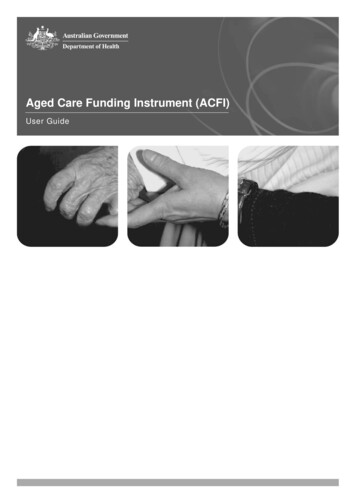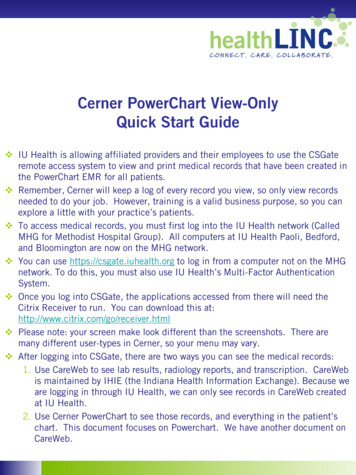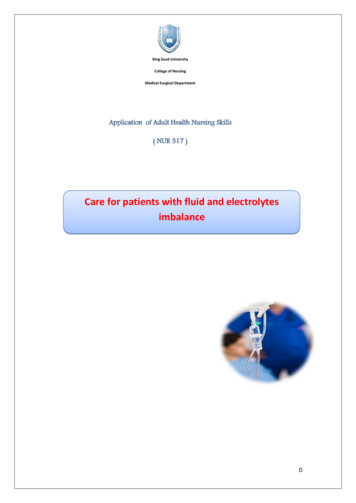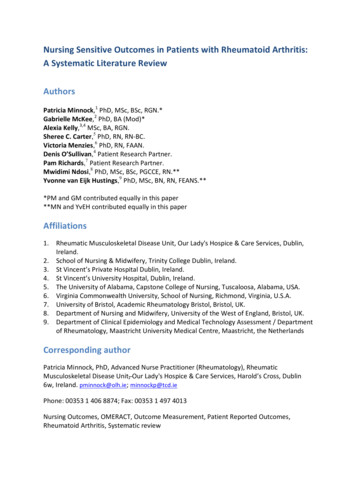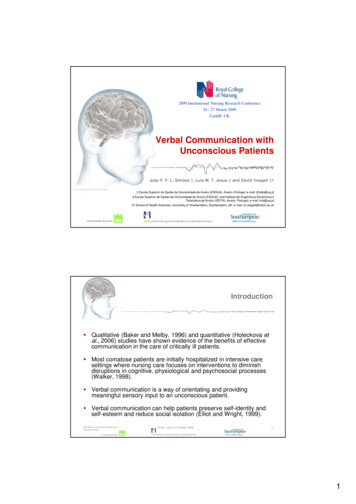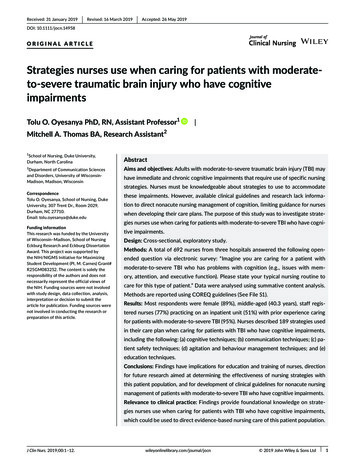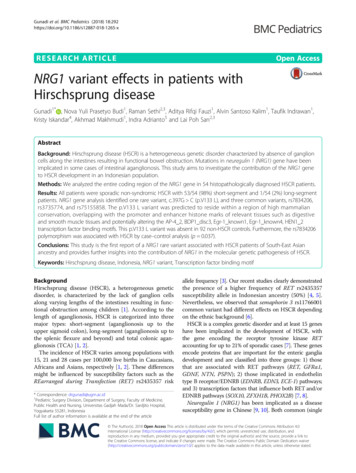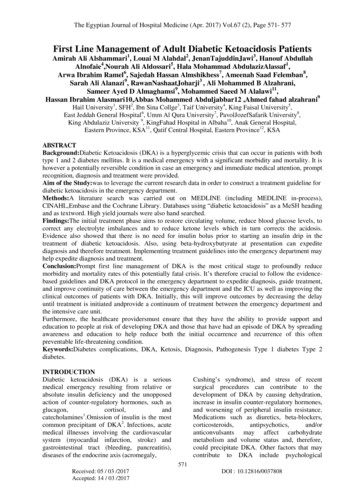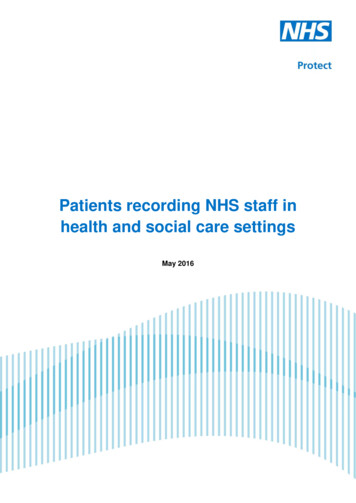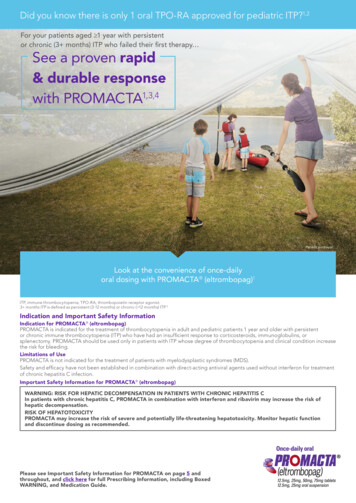
Transcription
Did you know there is only 1 oral TPO-RA approved for pediatric ITP?1,2For your patients aged 1 year with persistentor chronic (3 months) ITP who failed their first therapy See a proven rapid& durable responsewith PROMACTA1,3,4Patient portrayal.Look at the convenience of once-dailyoral dosing with PROMACTA (eltrombopag)1ITP, immune thrombocytopenia; TPO-RA, thrombopoietin receptor agonist.3 months ITP is defined as persistent (3-12 months) or chronic ( 12 months) ITP.5Indication and Important Safety InformationIndication for PROMACTA (eltrombopag)PROMACTA is indicated for the treatment of thrombocytopenia in adult and pediatric patients 1 year and older with persistentor chronic immune thrombocytopenia (ITP) who have had an insufficient response to corticosteroids, immunoglobulins, orsplenectomy. PROMACTA should be used only in patients with ITP whose degree of thrombocytopenia and clinical condition increasethe risk for bleeding.Limitations of UsePROMACTA is not indicated for the treatment of patients with myelodysplastic syndromes (MDS).Safety and efficacy have not been established in combination with direct-acting antiviral agents used without interferon for treatmentof chronic hepatitis C infection.Important Safety Information for PROMACTA (eltrombopag)WARNING: RISK FOR HEPATIC DECOMPENSATION IN PATIENTS WITH CHRONIC HEPATITIS CIn patients with chronic hepatitis C, PROMACTA in combination with interferon and ribavirin may increase the risk ofhepatic decompensation.RISK OF HEPATOTOXICITYPROMACTA may increase the risk of severe and potentially life-threatening hepatotoxicity. Monitor hepatic functionand discontinue dosing as recommended.Please see Important Safety Information for PROMACTA on page 5 andthroughout, and click here for full Prescribing Information, including BoxedWARNING, and Medication Guide.
For patients aged 1 year with 3 months ITP who failed their first therapy R APID & DUR ABLE, REDUCED MEDICATIONSf Primary end point: The proportion of patients who706050Patients, %PROMACTA demonstrated Platelet levels 50,000/mcL as early as Week 1340achieved a response (defined as platelet count 50,000/mcL) at least once between Weeks 1 and 6of the randomized, double-blind period3PETIT response rates1PROMACTAf Platelet count at baseline: 51% of patients had48%62% 15,000/mcL1f Platelet count at Week 1: 24% of patients receivingPROMACTA (eltrombopag) achieved 50,000/mcLvs 14% with placebo3DIFFERENCE30PLACEBO32%20100(n 7/22)(n 28/45)P 0.011PETITPhase 2, 7-week, double-blind trial in children 1 year of agewith relapsed or refractory ITP, followed by a 17- or 24-weekopen-label extension phase for patients from the PROMACTAand placebo arms of the double-blind phase, respectively.1,3Sixty-seven patients were randomized 2:1 to PROMACTA (n 45)or placebo (n 22) and permitted to use maintenance therapy,including (but not limited to) steroids, azathioprine, danazol,CsA, and mycophenolate mofetil. Platelet response wasevaluated for 3 age cohorts: 1) 12 to 17 years, 2) 6 to 11 years,and 3) 1 to 5 years.1Did you know PROMACTA was proven to reduce theneed for concomitant medications?1,3,4PROMACTA demonstrated Did you know PROMACTA was proven to providea rapid and durable response?1,3,4Reduction or discontinuation of concomitant ITPmedications, such as steroids or IVIg1,3,4During the open-label extension phasesof both pediatric trials 46%53%(6/13)(8/15)PETITPETIT 270achieved a response (defined as platelet count 50,000/mcL) for at least 6 of the 8 weeks betweenWeeks 5 and 12 of the double-blind period1,4PETIT 2 response rates160f Platelet count at baseline: 62% of patients had 15,000/mcL150Phase 3, 13-week, double-blind trial to assess the efficacyand safety of PROMACTA in children 1 year of age withrelapsed or refractory ITP, followed by a 24-week open-labelextension phase.1,4 Ninety-two patients were randomized2:1 to PROMACTA (n 63) or placebo (n 29) and permittedto use maintenance therapy, including steroids, IVIg, CsA,mycophenolate, azathioprine, and dapsone. Platelet responsewas evaluated for 3 age cohorts: 1) 12 to 17 years, 2) 6 to11 years, and 3) 1 to 5 n 1/29)(n 26/63)P 0.001PETIT 2Response rates with PROMACTA wereconsistent across all age groups1,3,4PROMACTA demonstrated f Primary end point: The proportion of patients whoPatients, %PROMACTA demonstrated Platelet levels 50,000/mcL for 6 weeks4*Reduced need for rescue therapy vs placebo1Percentage of patients requiring rescue therapyin the placebo-controlled phasePLACEBO50%PROMACTA13%(n 6/45)PROMACTA19%24%PETIT(n 11/22)(n 12/63)Important Safety Information for PROMACTA (eltrombopag) (continued)HepatotoxicityPROMACTA may increase the risk of severe and potentially life-threatening hepatotoxicity.Treatment of ITP, chronic hepatitis C, and refractory severe aplastic anemia Measure serum alanine aminotransferase (ALT), aspartate aminotransferase (AST), and bilirubin prior to initiation of PROMACTA,every 2 weeks during the dose-adjustment phase, a nd monthly following establishment of a stable dose2Please see Important Safety Information for PROMACTA on page 5 and throughout, and click herefor full Prescribing Information, including Boxed WARNING, and Medication Guide.PLACEBOCsA, cyclosporine A; IVIg, intravenous immunoglobulin.3 months ITP is defined as persistent (3-12 months) or chronic ( 12 months) ITP.5* In the extension phase of the study, platelet levels were maintained 50,000/mcL for a mean of 8.6 weeks anda median of 6 weeks.4PETIT 2(n 7/29)
For patients aged 1 year with 3 months ITP who failed their first therapy Did you know only 5% of patients treated withPROMACTA (8/156) discontinued due to adverseevents across all phases?1,3,4Safety established in 2 pediatric trials with patients aged 1 yearand older1Adverse Reactions ( 3%)1,aPROMACTA (n 107)Placebo (n 50)Upper respiratory tract a9%2%Pyrexia9%8%Abdominal pain8%4%Oropharyngeal pain8%2%Toothache6%0%ALT increasedb6%0%Rash5%2%AST increased4%0%Rhinorrhea4%0%The adverse reactions listed above were pooled from the placebo-controlled phases of the PETIT and PETIT 2 clinical trials.Includes adverse reactions or laboratory abnormalities 3 ULN.aS A F E T Y, O N C E - DA I LY O R A L D O S I N GDid you know even patients who can’t swallow a pillcan take once-daily oral PROMACTA?1Recommended starting dose1Aged 6 and olderAged 1 to 512.5 mg25 mg50 mg12.5 mg75 mg25 mg50 mg75 mgf For patients aged 6 years and older who are of Asian ancestry or who have mild to severe hepatic impairment, initiatePROMACTA (eltrombopag) at a reduced dose of 25 mg once dailyf For patients aged 6 years and older who are of Asian ancestry with hepatic impairment, consider initiating at a reduceddose of 12.5 mg once dailyPROMACTA has a maximum dosage of 75 mg per dayPatients can take PROMACTA without foodor with food that is low in calcium ( 50 mg)1f PROMACTA should be taken 2 hours before or 4 hours after medications such as antacids and mineral supplements or foodshigh in calciumPROMACTA offers the option of a once-daily oral formulation1f Any time of day1f No need for office visits for weekly injections and less drug wastage1,6With 2 oral formulations, PROMACTA is availableeven for patients who have difficulty swallowing a pill1bf PETIT: 6.8% of patients experienced grade 3 and 4.5% of patients experienced grade 4 adverse events in theplacebo-controlled phase3f PETIT 2: 12.7% of patients experienced grade 3 and no patients experienced grade 4 adverse events in theplacebo-controlled phase4Important Safety Information for PROMACTA (eltrombopag) (continued)Hepatotoxicity (continued)Treatment of ITP, chronic hepatitis C, and refractory severe aplastic anemia (continued) PROMACTA inhibits UGT1A1 and OATP1B1, which may lead to indirect hyperbilirubinemia. If bilirubin is elevated, performfractionation Evaluate abnormal serum liver tests with repeat testing within 3 to 5 days. If the abnormalities are confirmed, monitor serum livertests weekly until resolved or stabilized Discontinue PROMACTA if ALT levels increase to 3 times the upper limit of normal in patients with normal liver function or 3 times baseline in patients with pretreatment elevations in transaminases and are progressively increasing; or persistent for 4 weeks; or accompanied by increased direct bilirubin; or accompanied by clinical symptoms of liver injury or evidence for hepaticdecompensation If the potential benefit for reinitiating treatment with PROMACTA outweighs the risk for hepatotoxicity, then consider cautiouslyreintroducing PROMACTA and measure serum liver tests weekly during the dose-adjustment phase. Hepatotoxicity may reoccur ifPROMACTA is reinitiated. If liver test abnormalities persist, worsen, or recur, then permanently discontinue PROMACTAThrombotic/Thromboembolic Complications Thrombotic/thromboembolic complications may result from increases in platelet counts with PROMACTA Reported thrombotic/thromboembolic complications included both venous and arterial events, and were observed at low and atnormal platelet counts Portal vein thrombosis has been reported in patients with chronic liver disease receiving PROMACTA To minimize the risk for thrombotic/thromboembolic complications, do not use PROMACTA in an attempt to normalize plateletcounts. Follow the dose-adjustment guidelines to achieve and maintain target platelet counts3Please see Important Safety Information for PROMACTA on page 5 and throughout, and click herefor full Prescribing Information, including Boxed WARNING, and Medication Guide.12.5 mg25 mg50 mgTablets not actual size.To learn more about PROMACTA for oralsuspension, scan the QR code with yourphone’s cameraALT, alanine aminotransferase; AST, aspartate aminotransferase; ULN, upper limit of normal.3 months ITP is defined as persistent (3-12 months) or chronic ( 12 months) ITP.575 mgOral Suspension12.5 mg, 25 mg
COMPREHENSIVE PATIENT SUPPORTNovartis Oncology Patient SupportSupport for your patients when they need it mostThe right resources at the right timeBrought to you by Novartis Oncology Patient SupportNovartis Oncology Patient Support is designed to help meet the needs of patients and caregivers by making it easierto access Novartis Oncology medicine(s). Our patient support programs include financial assistance, information aboutlifestyle support, and more.PROMACTATo learn more about support for your patients,call 1-800-282-7630 or visit HCP.Novartis.com/AccessPatient Assistance Now Oncology : Assistance. Access. Answers.f Patient Assistance Now Oncology (PANO) is a support center consisting of dedicated case managers who provide informationto patients and HCPs regarding coverage and costs of medicines specific to a patient’s insurance plan. These case managersalso help direct callers to additional Novartis Oncology Patient Support programs that best fit their needsUniversalCo-pay Program— 0 co-pay with commercial insurancePatients may be eligible for co-pay savings on their next prescription of PROMACTA (eltrombopag). f Eligible patients with private insurance may pay 0 per monthf Novartis will pay the remaining co-pay, up to 15,000 per calendar year, per product*f Your patients can learn if they are eligible for the Novartis Oncology Universal Co-pay Program by visitingCopay.NovartisOncology.com or calling 1-877-577-7756Patient portrayal.*Limitations apply. This offer is only available to patients with private insurance. The program is not available for patients who are enrolled in Medicare, Medicaid, or anyother federal or state health care program. Novartis reserves the right to rescind, revoke, or amend this program without notice. For full Terms and Conditions, visitCopay.NovartisOncology.com or call 1-877-577-7756.Help your patients start on Day 11:Ask about our sample and voucher programFree Trial Programf The PROMACTA 14-day free trial is designed to provide a temporary supply of medicine that will allow patients tobegin therapy quickly for a US Food and Drug Administration–approved indication. Eligible patients with a validprescription can receive a free trial supply via mail. (Eligibility may vary)Financial assistance may be available for eligibleunderinsured or uninsured patientsf You can help your patients apply for this program by submitting the Novartis Service Request Form, available atHCP.Novartis.com/Accessf The Novartis Patient Assistance Foundation, Inc. (NPAF), an independent charitable organization, may provide financialassistance for Novartis Oncology medicine(s) to patients experiencing financial hardship with limited or no prescriptioncoverage. Patients who meet the following eligibility requirements may be qualified to receive Novartis medicine(s) at no cost: US resident Proof of income that meets the financial eligibility requirement Limited or no prescription coverage§Patient Navigator Programf The Novartis Patient Navigators are a dedicated team of specialists who support eligible patients during theirtreatment journeys†f New patients seeking NPAF assistance are required to submit the Patient Assistance Now Oncology Service Request Formf Patients receive a series of phone calls from a specially trained navigator who will support and guide them throughvarious aspects of taking their prescribed medicines†‡4f To learn more, call NPAF at 1-800-277-2254 or visit PAP.Novartis.com‡Patient Navigator services do not involve the practice of nursing or provide clinical advice and counseling. Medical inquiries will be directed to HCP or office staff.Must be prescribed a Novartis Oncology medicine for an approved indication that is offered within the Patient Navigator Program.Please see Important Safety Information for PROMACTA on page 5 and throughout, and click herefor full Prescribing Information, including Boxed WARNING, and Medication Guide.§Exceptions exist for individuals with limited prescription coverage. Please be advised that access to the medicines distributed through the Novartis Patient AssistanceFoundation, Inc., is free of charge to all eligible patients.HCP, health care professional.
IMPORTANT SAFET Y INFORMATIONIndication and Important Safety InformationIndication for PROMACTA (eltrombopag)PROMACTA is indicated for the treatment of thrombocytopenia in adult and pediatric patients 1 year and olderwith persistent or chronic immune thrombocytopenia (ITP) who have had an insufficient response to corticosteroids,immunoglobulins, or splenectomy. PROMACTA should be used only in patients with ITP whose degree ofthrombocytopenia and clinical condition increase the risk for bleeding.Limitations of UsePROMACTA is not indicated for the treatment of patients with myelodysplastic syndromes (MDS).Safety and efficacy have not been established in combination with direct-acting antiviral agents used without interferonfor treatment of chronic hepatitis C infection.Important Safety Information for PROMACTA (eltrombopag) WARNING: RISK FOR HEPATIC DECOMPENSATION IN PATIENTS WITH CHRONIC HEPATITIS CIn patients with chronic hepatitis C, PROMACTA in combination with interferon and ribavirin mayincrease the risk of hepatic decompensation.RISK OF HEPATOTOXICITYPROMACTA may increase the risk of severe and potentially life-threatening hepatotoxicity. Monitorhepatic function and discontinue dosing as recommended.HepatotoxicityPROMACTA may increase the risk of severe and potentially life-threatening hepatotoxicity.Treatment of ITP, chronic hepatitis C, and refractory severe aplastic anemia Measure serum alanine aminotransferase (ALT), aspartate aminotransferase (AST), and bilirubin prior to initiation ofPROMACTA, every 2 weeks during the dose-adjustment phase, and monthly following establishment of a stable dose PROMACTA inhibits UGT1A1 and OATP1B1, which may lead to indirect hyperbilirubinemia. If bilirubin is elevated,perform fractionation Evaluate abnormal serum liver tests with repeat testing within 3 to 5 days. If the abnormalities are confirmed, monitorserum liver tests weekly until resolved or stabilized Discontinue PROMACTA if ALT levels increase to 3 times the upper limit of normal in patients with normal liverfunction or 3 times baseline in patients with pretreatment elevations in transaminases and are progressivelyincreasing; or persistent for 4 weeks; or accompanied by increased direct bilirubin; or accompanied by clinicalsymptoms of liver injury or evidence for hepatic decompensation If the potential benefit for reinitiating treatment with PROMACTA outweighs the risk for hepatotoxicity, then considercautiously reintroducing PROMACTA and measure serum liver tests weekly during the dose-adjustment phase.Hepatotoxicity may reoccur if PROMACTA is reinitiated. If liver test abnormalities persist, worsen, or recur, thenpermanently discontinue PROMACTAThrombotic/Thromboembolic Complications Thrombotic/thromboembolic complications may result from increases in platelet counts with PROMACTA Reported thrombotic/thromboembolic complications included both venous and arterial events, and were observed atlow and at normal platelet counts Portal vein thrombosis has been reported in patients with chronic liver disease receiving PROMACTA To minimize the risk for thrombotic/thromboembolic complications, do not use PROMACTA in an attempt to normalizeplatelet counts. Follow the dose-adjustment guidelines to achieve and maintain target platelet countsIncreased Risk of Death and Progression of Myelodysplastic Syndromes (MDS) to Acute Myeloid Leukemia (AML) In a clinical trial of patients with intermediate- to high-risk MDS and thrombocytopenia receiving PROMACTA, anincreased number of progressions from MDS to AML and deaths have been observed compared to placebo PROMACTA is not indicated for the treatment of patients with MDSCataracts Development or worsening of cataracts with PROMACTA has been reported with a frequency of 5% to 11% in 6 clinicalstudies Perform a baseline ocular examination prior to initiating PROMACTA. Regularly monitor patients for signs andsymptoms of cataracts while on PROMACTALaboratory Monitoring Monitor serum liver tests During therapy with PROMACTA, assess complete blood counts (CBCs) with differentials, including platelet counts,weekly until a stable platelet count has been achieved. Monitor platelet counts monthly thereafter Obtain CBCs with differentials, including platelet counts, weekly for at least 4 weeks following discontinuation ofPROMACTA When switching between the oral suspension and tablet, assess platelet counts weekly for 2 weeks, then followstandard monthly monitoringDrug/Drug and Drug/Food Interactions PROMACTA must be taken at least 2 hours before or 4 hours after any medications or products containing polyvalentcations such as antacids, calcium-rich foods, and mineral supplements Take PROMACTA without a meal or with a meal low in calcium ( 50 mg)5Please see Important Safety Information for PROMACTA throughout, and click herefor full Prescribing Information, including Boxed WARNING, and Medication Guide.Adverse ReactionsAcross all indications, the most common adverse reactions ( 20% in any indication) were anemia, nausea, pyrexia, ALTincreased, cough, fatigue, headache, and diarrhea.The most common adverse reactions in 3 placebo-controlled clinical trials in patients with persistent or chronic ITP( 3% and greater than placebo) for PROMACTA were nausea (9%), diarrhea (9%), upper respiratory tract infection (7%),vomiting (6%), increased ALT (5%), myalgia (5%), urinary tract infection (5%), oropharyngeal pain (4%), increased AST (4%),pharyngitis (4%), back pain (3%), influenza (3%), paresthesia (3%), and rash (3%).The most common adverse reactions in 2 placebo-controlled clinical trials in patients with persistent or chronic ITP 1 yearand older ( 3% and greater than placebo) for PROMACTA
PROMACTA is indicated for the treatment of thrombocytopenia in adult and pediatric patients 1 year and older with persistent or chronic immune thrombocytopenia (ITP) who have had an insufficient response to corticosteroids, immunoglobulins, or . f The Novartis Patient Assistance Foundation,
